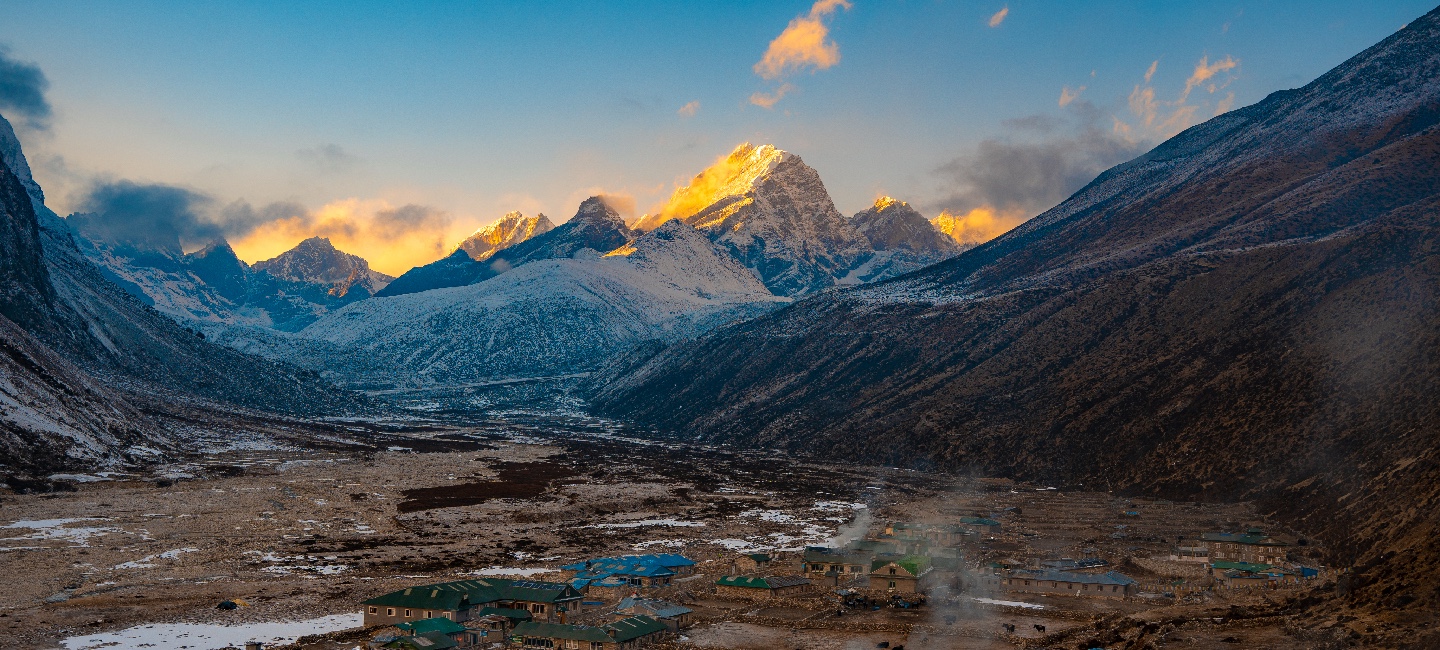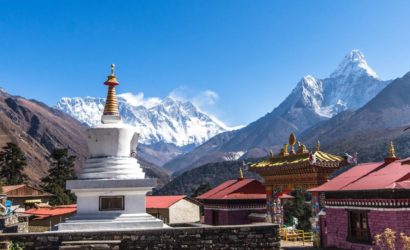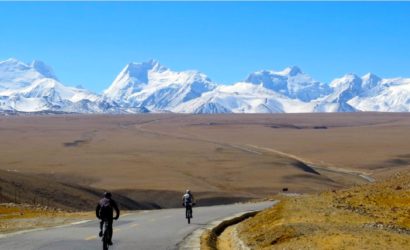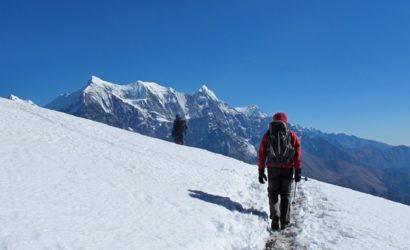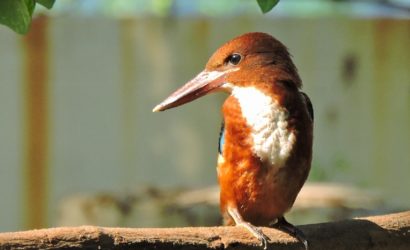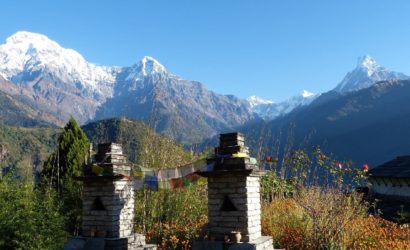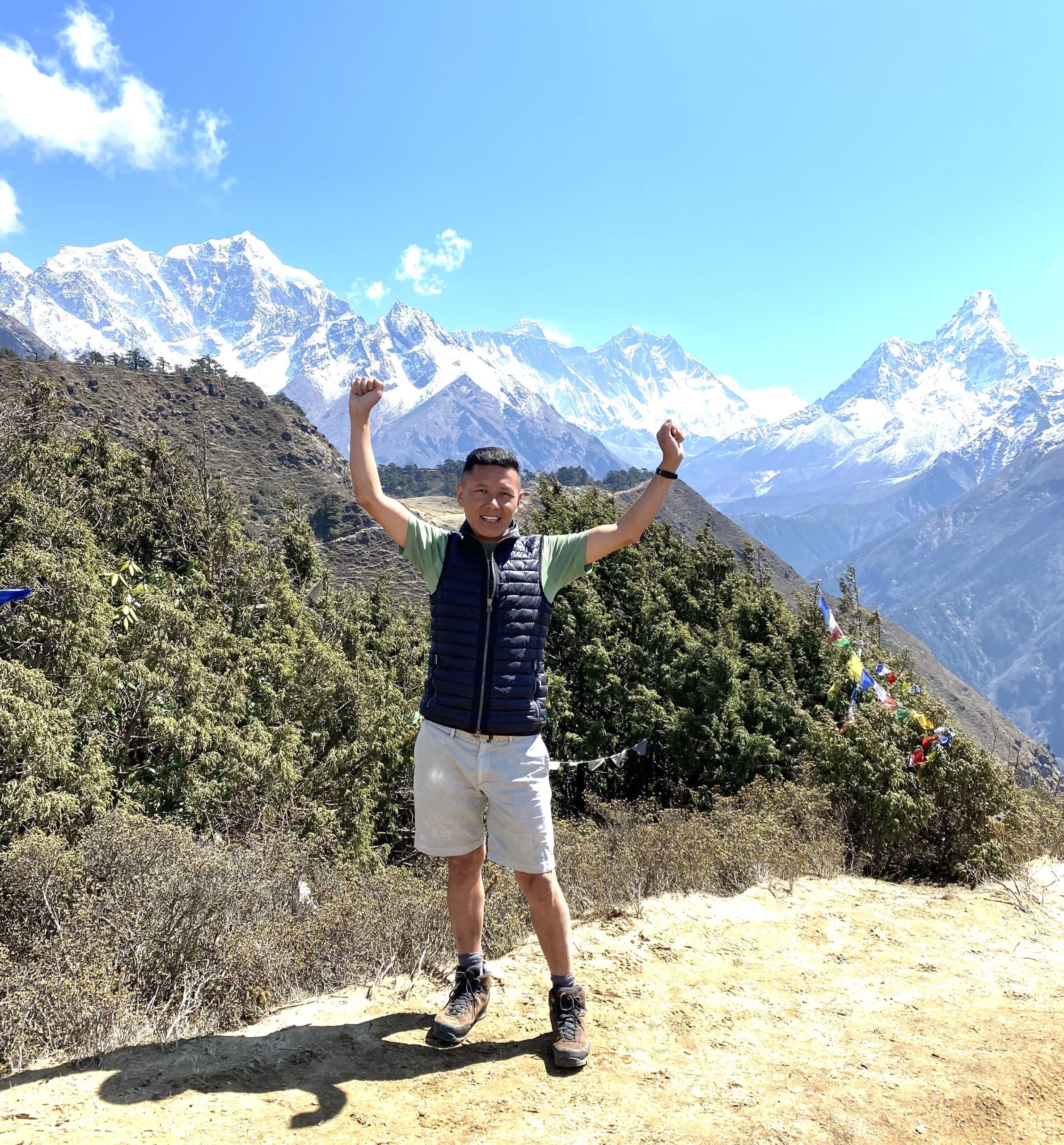The Everest three pass trek 17 days is an amazing journey through the Everest-Gokyo region offering you the ultimate trekking experience.
In this trek, you will witness spellbinding mountain views. Along with the glaciers, ancient valleys, and challenging passes. This trek is great for the ambitious trekkers who have the determination to cross three of the highest passes- Kongma La- 5535 meters, Cho La- 5360 meters and Renjo La- 5385 meters.
Moreover, crossing the three high passes while hiking to the three pinnacles of Gokyo Ri, Kalapathar, and Everest Base Camp makes this trek more unique and appealing.
In this trek, the trekkers fly from Kathmandu to Lukla before beginning the trek. You will hike through stunning Namche, Tengboche, Dingboche and other equally beautiful places. The locals that are the Sherpas who are famous for climbing the mountains. You will be able to experience their unique culture and lifestyle.
Also, the Sagarmatha National park that aims at protecting the diverse flora and faunas lies under the Khumbu region. Here you will see the different exotic species like Musk deer, mountain goat, snow leopard etc.
On the way you will see many bridges, monasteries, chortens with colorful Buddhist flags which gives life to the rough terrain of the mountains.
The best time to take this trek is from March to May in Spring and from September to November in Autumn.
This is a physically demanding trek, so you must be physically fit before going for this trek. And, the previous trekking experience is a bonus for this trek.
Overall, this trek is a perfect amalgamation of amazing landscapes, unconventional culture and thrilling adventure that you don’t want to miss.
Feel free to contact us to know more about the trip.
Everest Three Passes Trek Highlights
- Adventurous flight from Kathmandu to Lukla and back
- Visit historical Tengboche monastery
- Mesmerizing view of the Khumbu Icefall
- Amazing sunrise from Kalapathar
- Witness the unique culture of the Sherpa people
- Cross the enthralling passes (Kongma La 5535 m, Cho La 5360 m, Renjo La 5385 m)
Everest Three Passes Trek Map
The Everest three pass trek map, also known as the Everest circuit trek. The trek starts and ends at Lukla (2,800 m), the trail also requires first crossing Kongma-La Pass (5535 m), then the Chola Pass (5,360 m) and then the Renjo La (5,535 m). The route also takes you to Gokyo-Ri at 5,483 m, the Everest Base Camp at 5,380 m.
Elevation: 1400 meters, Kathmandu
On this day, one of our representatives will pick you from the airport and drive you to your respective hotel.
Once you reach the hotel you will check in and rest for a while. The remaining day you can explore Thamel looking at shops and eating at a restaurant.
Overnight at hotel in Kathmandu.
Elevation: 2651 meters, Phakding
Trekking duration: 3 hrs
Today early in the morning you will board a 35-minute flight to Lukla from Manthali airport, gateway to Everest. This will be a scenic flight with spectacular mountain views.
Please note: Kathmandu to Lukla flight has been moved to Manthali airport, Ramechhap in peak trekking season Spring (March, April, May) and Autumn (September, October, November) due to increased traffic and since March 2019 renovations at Kathmandu airport. Manthali airport can be reached by road from Kathmandu within 4 to 6 hours drive. This means you need to wake up early in the morning around 2:30 am to take a drive and catch your Lukla flight from Manthali early in the morning.
Once you reach Lukla, you will meet your porter, guide and other teammates. You will then eat a wholesome breakfast after which the trek begins.
You will trek to Phakding to the north at 2651m. This will be an easy 3 hrs trek through the Dudh Kosi valley. You will then proceed from the airstrip to Cheplung and cross the crystal clear Thado Koshi on a suspension bridge.
Once you pass the bridge you will get the view of Kusum Kanguru which is one of the toughest mountains to conquer.
Away from Thado Koshi, you will continue towards the Ghat and cross a ridge marked with painted Mani stones. From here, the trail climbs gently and in about an hour you will reach Phakding. Overnight at a lodge in Phakding.
Elevation: 3438 meters, Namche Bazaar
Trekking duration: 5-6 hrs
This is the second day of your trek where you will head to Namche Bazaar, a famous village in the Khumbu region.
On your way to Namche, you will cross through beautiful pine forest, along the Dudh Koshi river. You will cross many suspension bridges via Sherpa villages like Benkar, Chimayo, Monjo, and Jorsale.
At Jorsale you will enter Sagarmatha National park where you will have to verify your permits. The trail then continues through the Dudh Koshi river bed to the confluence of Bhote Koshi and Dudh Koshi rivers.
Later you will climb steadily and cross the high Tenzing Hillary suspension bridge. On the way, you will get an inspiring glimpse of Mt.Everest right up to Nuptse-Lhotse ridge. About 3 hours ascend through the wonderful pine forest you will reach Namche Bazaar, the chief economic hub of the region.
From Jorsale it is a two and a half hour ascends to Namche with two major viewpoints on your way. On a clear day, you will get the magnificent view of the Everest.
Hiking duration: 5 hrs
Today is the scheduled acclimatization day of the trek. As you trek to harsh geography and high altitude region it is important to adjust and adapt before proceeding further.
This will help to avoid altitude sickness and unwanted illness. However, you will not spend the day being lazy. Instead, you will roam around to stay active.
You can also visit the Sagarmatha National park visitor center on the hillock. Here you can observe an assortment of things related to the first Everest ascenders, Sherpa culture. And learn about various plants and animal life of the Everest region.
Or, you can take an acclimatization side trip to large traditional Sherpa villages, Khunde and Khumjung. An hour-long climb to the Syangboche airstrip will steadily ascend towards Khunde.
On the way up, you will see century’s old chorten. From there, you will move eastwards to Khumjung, the largest settlement in the whole Khumbu region.
You can enjoy lunch at Khumjung after which you will take a slow climb to the Everest View Hotel. From here you will enjoy the view of the Himalayas. The descend to Namche is approx 4-5 hrs.
Overnight at a lodge in Namche.
Elevation:3956 meters, Tengboche
Trekking duration:5 hrs
After your breakfast at Namche, you will start your hike to Tengboche. The estimated distance is about 10km. The trail leads moderately flat with a great view of Mt. Everest, Nuptse, Lhotse, Ama Dablam etc.
By now, you will be familiar to the strong wind and rough terrain. The trail progressively becomes narrower and steep.
You will come across numerous monasteries, suspension bridges, waterfalls and rhododendron forests. And after about 2 hours of walk, you will reach Tengboche. In Tengboche, you can visit one of the oldest monasteries in Nepal. Here you can be a part of the unique and spiritual Buddhist rituals. Overnight at a lodge in Tengboche.
Elevation:4440 meters, Dingboche
Trekking duration:4-5 hrs
Today’s trail descends to Dingboche which is a small village with chortens, Mani stone walls, and nun monastery.
You will cross a suspension bridge over Imja Khola and gradually make your ascent to Pangboche. Here you will get the towering view of Ama Dablam.
The trail then follows up-stream closer to Imja Khola up towards Imja valley. And, you will cross a few Sherpa villages where you will reach Dingboche.
Dingboche is the last Sherpa settlement with the beautiful terraced field enclosed by a stone wall. Overnight at a lodge in Dingboche.
Elevation: 4940 meters, Lobuche / 5535 meters, Kongma La Pass
Trekking duration:10 hrs
Today will be a long day as you start your day early. You will continue your ascent, a few hours walk to Chhukung where you can see the beautiful mountains up close.
In Chukung, you will take a short break before you take on the highest pass of the trip today. You can carry water and pack lunch as there are no tea shops on the way. You will really enjoy the remoteness of the area and the absolute nature.
From here you can go via any of the two trails. One by climbing the hill northwest of Chukung over the moraine of the Nuptse Glacier. Or you can walk down the valley to Bibre and follow a high trail above the Niyang Khola.
After some walk, you will get great views of the Island peak, valley and jagged ridge of Amphu Lapcha. As you ascend along the east side of Niyang Khola valley, you will turn west and walk through the sloppy stone trail. You will enter a wide basin dotted with small frozen lakes.
The trail then rises over loose scree gaining the Kongma La. After about 5 hrs, you leave Chukung. Upon reaching the top you will see piles of stones wrapped in prayer flags that mark the pass.
Behind is the landscape of icy lakes below which is the Khumbu glacier. The final descent is the toughest part of the trek.
After climbing the moraine on the far side, the trail then turns north through Khumbu glacier which ends at Lobuche. Overnight at a lodge in Lobuche
Elevation: 5368 meters, Everest Base Camp
Trekking duration: 3-4 hrs
Today’s trail follows the windy and rocky path with the crest of a north ridge to Everest along with Mt.Pumori, Mahalangur, Lingtern, Khumbutse, Nuptse etc.
The trail continues along the side of Khumbu glacier to Gorakshep. Here you will check into the Hotel and have your lunch. During the afternoon you will set out to visit the world’s highest base Camp, the Everest Base Camp.
Everest Base Camp offers an amazing view of Khumbu icefall. And the colorful campsite of Everest expedition during expedition season. Later you will trek back to Gorakshep for overnight at lodge.
Elevation:5545 meters, Kala Patthar
Trekking duration: 6-7 hrs
Today early in the morning you will begin your trek. You will get remarkable views of the sunshine gleaming on the face of Everest from Kala Patthar
In the morning, it will be all dark with cold temperature approx 10 to 15 degree Celsius. You will trek to Kala Patthar where you will get unbelievable mountain views that will take your breath away.
Here you can take beautiful pictures from the top of Kala Patthar for memories to take back home. You will then return to Lobuche where you will spend the night.
Elevation: 4830 meters, Dzongla
Trekking duration: 4hrs
Today’s trek will be short in comparison to the trek of the other days. The path to Dzongla branches off the main trail before some distance from Lobuche.
You will then cross a stream through a fork and later curve around the wide graveled river bed. The trail runs across the river bed and climbs the ridge ahead. From the grassy ridge ahead, the trails run southeast from where you can see the heights of Ama Dablam and Kangtega to Thamserku.
Pheriche village is also visible down in the distance. As the ridge changes the direction northward, the vast Chola Pass speaks below Mt. Cholatse.
The lakes stay with you over a long stretch until you descend to a wide basin. The trail climbs further to a spur and descends slowly on another basin.
After a traverse from the basin and shortly after crossing a shaky bridge, you will reach Dzongla. Overnight at a lodge in Dzongla.
Elevation: 4800 meters, Gokyo valley / 5360 meters, Chola Pass
Trekking duration: 8-9 hrs
After having your breakfast early in the morning, you will move out of your lodge where you will get the sight of Cholatse looming over you.
Today’s trek is going to be the toughest days of your trip. The walk begins as you walk through a spur extending westward from Dzongla.
The path descends to a basin across which wanders through a stream. In about an hour, you will reach the top of the basin ready to take on the Cho La. As you gain height, the view gets more captivating.
The Cho La begins to appear. Climbing the incline will not be easy. It is steep with boulders over some of which you have to climb. The final climb to the Cho La can be a little tricky.
Upon reaching the top, you will see prayer flags flapping in the strong wind. The scene of majestic peaks from all direction is breathtaking.
From here the path leading to Thragnak is long but you can easily make it out from the Cho La Pass because it is just decent. You will then reach Thragnak, a small village. Stepping out the settlement, the trail takes you to the Ngozumpa glacier’s edge after a short walk.
As you reach the other side of the glacier you will get a sight of the second of the Gokyo lakes among a series of six lakes. A little further is the third Gokyo lake.
On the edge of the lake stands the village of Gokyo where you will finally take rest from a tiring day.
Overnight in Gokyo.
Elevation: 5367 meters, Gokyo Ri
Trekking duration: 4 hrs
Today is a rest day at Gokyo village. You will love the view of charming sites of Gokyo village. If the day is pleasant you can climb the Gokyo Ri and enjoy the view of the Everest region.
The Gokyo region not only offers a view of Gokyo peak but also gives you wonderful chance to witness the series of six emerald lakes.
Moreover, you can climb on the hill and get amazing views of Mt. Cho Oyu, Gyachung Kang, Everest, Lhotse, Nuptse etc.
Cho Oyu base camp lies beyond the fifth lake from where you can get the view of the Ngozumpa glacier.
Later you will return to Gokyo village and spend overnight at your lodge.
Elevation: 4310 meters, Lunden / 5385 Renjo La
Trekking duration: 6 hrs
Today you have to start the trek at the break of dawn as you have to go up to Marlung after exploring the Renjo La pass. As you won’t stay overnight at Marlung, you need to start early.
From the Gokyo valley, you will leave the main trail and turn to Renjo La trail through Dudh Pokhari. After about 3 hrs, you will reach the Renjo La where an amazing vista awaits.
Views of Renjo La are similar to that of Gokyo Ri with third Gokyo lake and Gokyo village beneath the Ngozumpa glacier. As you proceed from the pass, the trail winds down a stone staircase and climb over loose stones to reach the small lake, Angladumba Tsho.
Along the way, you will see Relama Tsho and Renjo lake. From here you will walk down through narrow valley with giant boulders to Lumde. After about an hour from Lumde, you will reach Marlung on the east bank of the Bhote Kosi. Overnight at Lungden.
Elevation: 3800 meters, Namche Bazaar
Trekking duration: 3 – 4 hrs
We will hike to Thame. Situated at 3800m, we will also visit the historic Thame monastery and experience spiritual Buddhist practices.
We can also witness the lovely culture of Sherpa people at Thame. We will spend the night here and enjoy the much-needed rest for our downhill trek tomorrow. Overnight at a lodge.
Elevation: 3440 meters, Namche Bazaar
Trekking duration: 5 hrs
We will continue our trek down the Sherpa villages of Khumjung, leaving the mountains in the backdrop. We will walk down to the village of Namche bazaar, epitome of Sherpa culture. Overnight at guesthouse.
You will pass through the rhododendron, pine, and oak forest. Overnight at a lodge in Lukla.
Elevation: 2860 meters, Kathmandu
Travel hours: 5 – 6 hrs
It is around 6 hours long walk downhill from Namche to Lukla. On this day, our time at exotic Sagarmatha National Park will come to an end. Following day, we will board a plane to capital. You will bid goodbye to this trek with a memorable walk down to Lukla. Overnight at guesthouse.
Elevation:1400 meters, Kathmandu
Travel hours: 30 minutes
The flights from Lukla to Kathmandu are mostly scheduled early in the morning to avoid strong winds.
It is a scenic flight back to Kathmandu. As you touch down at Kathmandu, you will drive to your hotel.
Please note that the flight can get delayed or canceled sometimes due to the weather. In that case, we expect the guest to be patient.
You can either stay back in Kathmandu today and enjoy a free day or say goodbye to the wonderful journey and head back to home.
Enjoy the delights of Kathmandu, taking a trip to a spa massage or listening to live music. Or simply relax in a quiet café or restaurant with a view of the Kathmandu.
Our representatives will drop you off at the airport according to your flight schedule.

